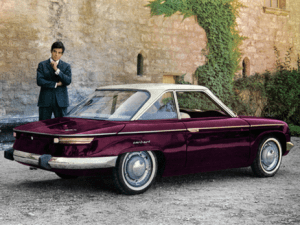Panhard was originally called Panhard et Levassor, and was established as a car manufacturing concern by René Panhard and Émile Levassor in 1887.

After World War II the company was renamed Panhard (without “Levassor”), and produced light cars such as the Dyna X, Dyna Z, PL 17, 24 CT and 24 BT. The company had long noted the weight advantages of aluminum, and this as well as postwar government steel rationing (designed to limit new car models to ensure an orderly return to production at the major firms), encouraged the firm to proceed with the expensive alternative of making the bodies and several other components out of aluminum; thus the Dyna X and early Dyna Z series 1 had aluminum bodies. Unfortunately, cost calculations by Jean Panhard himself, inheriting son and managing director of the firm, failed to account fully for all of the extra cost of aluminum vs steel, as his calculation were made for the sheet metal panel area actually utilized per body shell, and erroneously did not account for the cut offs and scrap of each of the stampings making up the shell.
Once in production, a re-examination cost analysis showed a cost of 55,700fr for aluminum shells and only 15,600fr for steel. The use of aluminum had pushed the firm perilously close to bankruptcy, and a rush engineering job saw the firm return to steel. Thus, the later Dyna Z (from mid September 1955) and the successor PL 17 bodies were steel.
The last Panhard passenger car was built in 1967. After assembling 2CV panel trucks for Citroën in order to utilize capacity in face of falling sales, and raising operating cash by selling ownership progressively to Citroën, respectively to its then mother company Michelin (full control as of 1965), in fall of 1967 the civilian branch was absorbed by Citroën, and the marque was retired. Since 1968 Panhard has only made armored vehicles.[15]
Today the only use of the name Panhard is the “Panhard rod” (also called Panhard bar). This is a suspension link invented by Panhard that provides lateral location of the axle. This device has been widely used ever since on other automobiles or as after-market upgrade to rear axles for vintage American cars.


